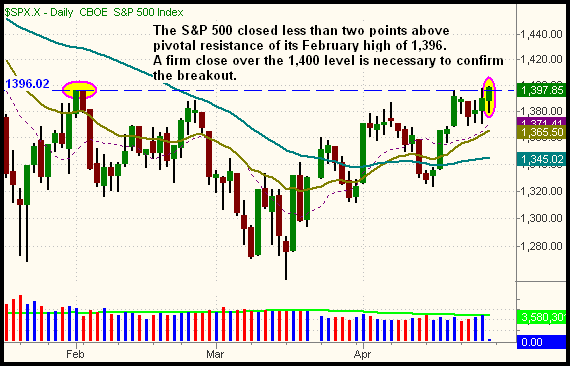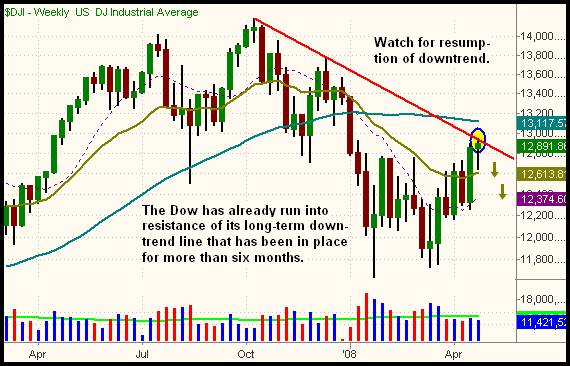|
The Wagner Daily ETF Report for April 28
A tug-of-war between the bulls and bears last Friday caused the major indices to finish at pivotal levels and with mixed results. After gapping higher on the open, stocks sold off throughout the morning, then grinded their way higher in the afternoon. Gaining 0.7%, the S&P 500 finished fractionally above the previous day's high. The Dow Jones Industrial Average and Nasdaq Composite lagged behind, advancing 0.3% and losing 0.3% respectively. Small and mid-cap stocks showed relative strength for a second straight day. The Russell 2000 closed 0.7% higher. Rallying 1.4%, the S&P Midcap 400 finished above its 200-day moving average for the first time this year. All the main stock market indexes settled near their intraday highs, though the Nasdaq and Dow failed to close above their morning highs.
Turnover eased across the board. Total volume in the NYSE declined 12%, while volume in the Nasdaq was 14% lighter than the previous day's level. Mixed market internals matched the varied closing prices of the major indices. Advancing volume in the NYSE exceeded declining volume by a margin of 2 to 1, but the Nasdaq adv/dec volume ratio was slightly negative.
Throughout last week, we extensively discussed resistance of the February 2008 high the S&P 500 was having difficulty overcoming. Last Thursday, the index probed above that 1,396 level on an intraday basis, but failed to close above it. The following day, the S&P 500 reversed early control of the bears to finish the week less than two points above that pivotal resistance level. Technically, the index will therefore start the new week above a key level of intermediate-term resistance. In actuality, however, the S&P 500 did not close far enough above the 1,396 level to declare a confirmed breakout. It's too early to know whether or not last Friday's action in the S&P was merely a "stop hunt" to trigger traders' protective stop orders before reversing back down. A closing price above the psychologically significant 1,400 level, accompanied by higher volume, is what the bulls want to see in the coming days. Be prepared for high volatility and whippy trading conditions as the bulls and bears battle it out this week:

Even if the S&P 500 manages to convincingly move above the 1,400 level, remember that resistance of its long-term weekly downtrend line is just overhead, presently around the 1,416 level. Speaking of long-term downtrend lines, let's briefly discuss the Dow Jones Industrial Average.
Showing relative strength to the S&P and Nasdaq, the Dow was the first of the main stock market indexes to rally above its prior high from February, but it already ran into its primary downtrend line last week. On the weekly chart below, we've annotated the primary downtrend line that has been in place for more than six months:

Recent strength in the overall market has been a little deceiving, as last week's gains in the major indices were largely the result of the financial stocks bouncing from oversold conditions. When the stock market is being led by sectors bouncing off their lows, rather than industries breaking out to new highs, the strength is often short-lived. In this case, an abundance of overhead supply in the financial arena will make it difficult for the financials, and the major indices, to move much higher in the near-term. Former market-leading sectors such as basic materials, oil, natural gas, and farming/fertilizers all pulled back last week. If those sectors don't immediately recover this week, the lack of clear sector leadership will undoubtedly weigh on the broad market.
With the Dow pressing against its well-established primary downtrend line, and the S&P and Nasdaq fast approaching their respective long-term downtrend lines, we've begun "dipping a toe in the water" on the short side of the market. The longer a trendline has been intact, the more likely the trend will continue. As such, we must assume the primary downtrends that began with last October's highs will remain intact until price action of the stock market proves otherwise. Several weeks ago, the reward/risk ratios favored the long side of the market, but that may be changing now. Still, it is dangerous to aggressively enter short positions without confirmation that bullish momentum has dried up. If not fully positioned in cash, consider adding at least one or two short positions (or inversely correlated ProShares ETFs) to your portfolio. Avoid getting too aggressive on either side of the market ahead of this Wednesday's meeting of the Federal Reserve Board and announcement on interest rates and economic policy.
Open ETF positions:
Long - UUP, SDS
Short - (none)
Deron Wagner is the Founder and Head Trader of both Morpheus Capital LP, a U.S. hedge fund, and Morpheus Trading Group, a trader education firm launched in 2001 that provides daily technical analysis of the leading ETFs and stocks. For a free trial to the full version of The Wagner Daily or to learn about Wagner's other services, visit MorpheusTrading.com or send an e-mail to deron@morpheustrading.com.
|